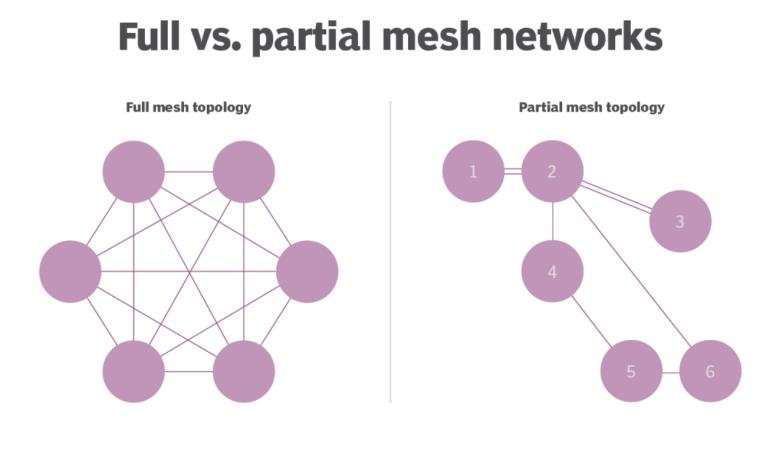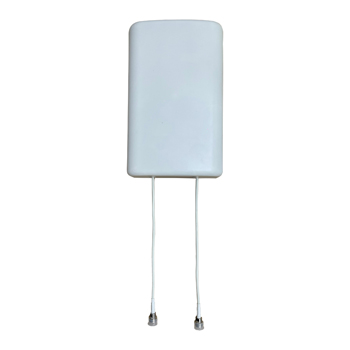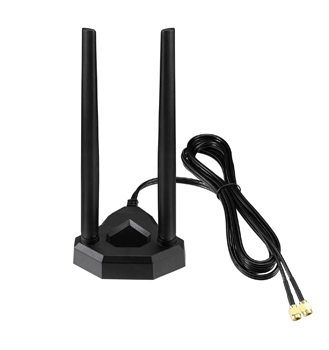Table of Contents
ToggleWhat is Mesh Network
Mesh network is the new technology in the field of wireless. The main purpose of the mesh network is to transmit the signal of Wi-Fi/internet in every corner of the house. Mesh network creates multiple routes between the connected nodes in order to transmit the information. The data transmit rate in the mesh network is very high compared to a simple network. As the mesh network has too many routes so there is no hurdle in data transmission. So the data is transmitted in the mesh network at a high rate. The mesh-based network topology is mostly used in big organizations and offices and somehow it’s also used in the offices. If any of one node is down in the mesh network the data is transmitted through another node. Multiple routers and switches are used in the large mesh network and these switches and the router behave as the nodes in the mesh network. The mesh network topology totally depends on the structure of the building. A mesh network can cover a huge area since it can have hundreds of wireless mesh nodes.
Mesh network uses several small routers or devices in order to cover the large network. In the mesh network, one device acts as the central node, and all the other devices are connected with the central device or node. The main central node is directly connected to the internet service provider. Mesh network is easily manageable through mobile application. You can control all the mesh networks by using the mobile application. You can monitor the data, easily manage the network issues, and also the set priority of any device by using the mobile application. You can use mobile apps to operate your network from your smartphone and manage it from anywhere at any time.
As discussed before, the mesh network is mostly used in big organizations, offices, and large homes because the mesh network uses too many routers that work together. These routers cover all the areas of the home, organization, and office. As the technology upgrade, day by day the value of the mesh network is also increasing in big homes and in the organization.
Types of Mesh Network:
There are six different types of mesh networks:
1. Wi-Fi Mesh Network
In the Wi-Fi mesh network, multiple devices are connected through a wireless connection. In Wi-Fi based mesh network one device acted as the main Wi-Fi router and all the other devices connected with the main node wirelessly. Most of the people use the Wi-Fi-based mesh network because its cost is very low compared to a wired mesh network. The main disadvantage of the Wi-Fi mesh network Its only support limited mobile devices. In Wi-Fi mesh network there is no cable is required for the connectivity. All the communication is done between the nodes wirelessly. This Wi-Fi network is totally different from the simple Wi-Fi network. Mesh network-based Wi-Fi uses special radio nodes which do not connect with wired harbor same as in the simple Wi-Fi-based network. The mesh network automatically selects the nearest hop in order to transfer the data at higher rates. Mesh-based Wi-Fi network is faster than the simple Wi-Fi network that operates by using a simple access point. The nodes that are running between the input and the output nodes act as forwarding nodes and select the best routes and send the data to the next device.
2. Wired Mesh Network
In a wired mesh network, multiple devices are connected through wired connection. All the nodes that are connected with the wired based mesh network must have the ethernet port. Router behaves as the main router in wired based mesh network. All the other nodes are connected to this main router. Some additional equipment is also required in the wired-based network. The router or the nodes that are deployed between the different nodes acts as bridge nodes. Wired based mesh network is more expensive than the Wi-Fi-based mesh network. The cost of the wired-based mesh network totally depends on how many nodes are required for the whole network.
3. Hybrid Mesh Network
A hybrid mesh network is the combination of both networks. The hybrid mesh network supports the wired mesh network and also supports the wireless-based mesh network. Two different types of the network communicate by using the Hybrid network. When using the wired interface the Hybrid nodes cover a larger region. As each node may communicate with other devices via the wireless interface, there are no connectivity lags, in contrast to Wi-Fi networks.
4. Client-Based Mesh Architecture Network
In a client-based Mesh Network, all the client nodes are connected with peers to peers. In a client-based mesh network, all the nodes act as data transmission nodes. In this type of network, the client-end device acts as a mesh router and sends data to all the devices.
5. Full Mesh Topology
There are two types of full mesh topology based on the requirement and budget. If the full mesh topology is wired based then the each device is connected with the other devices by using the wire. When compared to other network topologies, the Full-Mesh topology offers a high level of redundancy. The fundamental benefit of a full-mesh topology is that there is always a backup route to the destination in case a connection between two devices fails. In Full-Mesh topology, Site-to-site WAN connectivity redundancy and server connectivity redundancy are both achieved.

6. Partial Mesh Topology
A partial mesh topology is the same as the full mesh topology. In the partial mesh, all the devices are not directly connected with other devices. Only some devices are connected to other devices. Some devices in a partial-mesh topology are linked to many other devices, while others are linked to only one or two. New devices can easily add in the partial mesh topology. Adding additional devices won’t stop the message from being sent. Mesh topology also demands less management and infrastructure work. When you need to increase a network’s coverage area, a partial mesh topology network can be useful. This is because mesh network nodes serve as data repeaters. As a result, the network is more resilient.
What can Tesswave do for you?
Tesswave provide 100+ antenna products and you can contact us for antenna customized solutions, get in touch with us today to get a Free quote.
Get an Instant Quote
Get a FREE quote and we will contact you within an hour
How does Mesh Network Work?
The devices that are used in the mesh network can be easily handled by using the software. In mesh network one device act as the main device. The main device is directly connected to the internet service and all the other devices are directly connected to the main device. Mesh network uses flooding and routing techniques in order to transmit the data to the next device. When mesh network uses the routing techniques then the message moves from one node to another node and vice versa and reaches its destination. The major benefit of mesh based network is that If any of one connection is broken then Its continuously make a new connection with the other device and transmit data continuously. Mesh network comes with the self-handling algorithm which helps in making a new connection whenever one connection is down. There are frequently multiple ways to get from one place to another.
Mesh network also used the flooding technique in order to transmit the data. In the flooding technique when one of the devices in the network is send data then it transmits to all the devices that are in the network. A portion of the nodes sends data because all nodes might not be accessible at once. A portion of the data is present on each node. To increase throughput, a protocol selects the senders for each data transmission.
Uses Cases of the Mesh Network
Mesh network is mostly used in large organizations and in the large homes. The size of the mesh totally depends on the size of the home or organization. Mesh networks are mostly used in the area of IoT. Wireless mesh network is a good choice if you are working on IoT based project. Mesh network can be used for:
- Mesh network used in the monitoring of electricity and microgrids.
- Mesh network used in Home monitoring.
- Mesh networks are used in security systems.
- Mesh networks are commonly used in city-scale systems such as street lighting and sensor-based measurement.
- Mesh networks are also used in the big industries in order to control and monitor the whole system of the Industry.
Benefits of the Mesh Network
- Mesh networks have Better coverage as compared to simple networks. In the Mesh a lot of devices work together which covers all the areas of the home or organization. All the devices in the Mesh Network work together which ensures that the strong wireless signal reaches every corner of the house or organization. It’s far better than the simple Wi-Fi network.
- In mesh network no dead zone occurs. In simple based Wi-Fi network where only one access point is used for the Wi-Fi as you move away from the device the strength of the signal is weak and a dead zone occurred but in the mesh network a lot of devices work together and cover all the corner of the house so mesh network eliminates the dead zone.
- The majority of mesh systems come with an easy-to-use smartphone app. You can use the app to learn more about the workings of your system. This indicates that you are no longer dependent on a big business to act as your system’s middleman. You have control all the network with just one finger.
- Mesh networks have more stability than other networks. When one of the connections in the mesh network is down and data is transmitted through another link so there is no downtime in the mesh network and more stability.
- In mesh network one device can directly communicate with the other device without involving the main router or the devices.
- No high power signal is required in the mesh network. It is not necessary for every device in the network to emit a signal powerful enough to go to the main access point.
- Mesh network provide better security than a simple network. If one of the devices in the mesh network is compromised then this device is easily replaceable and it does not affect the whole network.
Drawbacks of the Mesh Network
- Mesh network is more costly than a simple network. Mesh network is mostly used in a big organizations. A lot of devices are used in the mesh network so it’s more expensive than the simple Wi-Fi Network.
- Due to the large network and lot of devices in the mesh network so it’s difficult to manage the whole network for a single person.
- Mesh network has more complexity than other networks. Each node in the mesh network acts as a router and send message to the other device. So if one of the nodes is down then it’s difficult to troubleshoot.
- Latency can be a problem with lower-power WANs since there might not be sufficient processing power to handle messaging.
Difference between Mesh Networks and a Wi-Fi range extender:
- Wi-Fi range extender covers only a small area and solves all the connectivity issues in the smaller area but the mesh network covers large and connects all the devices in a larger area and it’s mostly used in big offices or industries. A Wi-Fi range extender is good for small offices.
- When the Wi-Fi extenders are configured Wi-Fi extender creates their own network then the user manually switches from one network to the other network but in mesh networks, on the other hand, create a seamless connection, which means that devices immediately connect to the closest node.
- Wi-Fi extender is easy to set up but the mesh network is more difficult to set up. Now mesh networks use a user-friendly interface to make setup as quick and easy as possible. The setup time for the entire system is often less than 15 minutes.
- The mesh network is more costly than the Wi-Fi range extender.
Conclusion
Mesh wireless network improves wireless coverage. Mesh network is smarter than a simple Wi-Fi network and performs better and also covers a larger area. Mesh networks are an excellent way to fix bad internet connections in hard-to-reach places like the basement, backyard, garage, etc. They may not be the ideal option in every circumstance, though but its best option in most situations.








